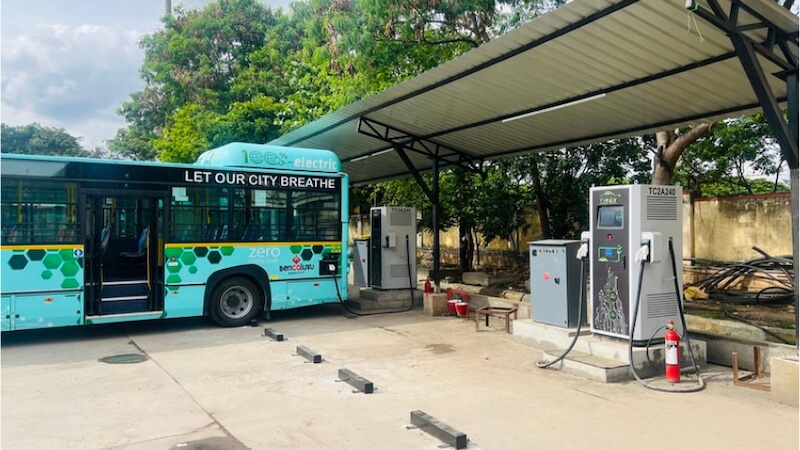GULF Oil acquires majority stake in DC charger maker Tirex chargers – Chat with CEO Arth Patel

Tirex Chargers is an EVSE manufacturer based out of Ahmedabad. Gulf Oil India is set to acquire a 51% stake in Tirex Chargers for INR 103 crores. This interaction with Arth Patel – Founder and CEO at Tirex Chargers, focuses on their work and the overall outlook for the EV charger manufacturing space.
Please tell us about Tirex Chargers’ current scale of operations.
We are a DC charger manufacturing company and can manufacture between 1500 to 2000 DC fast chargers a year at the moment. We started in 2016 and have supplied nearly 700 DC chargers across India, with a combined capacity of around 30,000 kilowatts. Our primary focus is on high-power charging – so most of our deployments cater to electric buses and electric car fleets.
Can you please share about the revenue and profitability of Tirex Chargers?
Since the last two to three years, we have been growing almost at a hundred per cent rate. Two years ago, we generated a revenue of around INR 7 crores. Last year, we did INR 13 crores; this year, we are targeting a top line of over INR 40 crores.
Also, last year we registered a minor profit. This year, we might incur a small loss due to heavier investments in R&D and scaling up our manufacturing capacity. As the majority of the capital investments are done in initial years, we expect at least 20-25% profits in five years down the line.
You have been manufacturing chargers since 2016. What were the main challenges you faced during this time?
When it comes to electronics, India still lacks competence as compared to other Asian countries. As an original equipment manufacturer, we rely on partners to supply certain electronic components. Finding local vendors for components such as PCBs, energy meters, or displays was a hurdle in India. So we had to go to China, Korea or Malaysia to source these components. However, we are gradually seeing a shift. It will still take some time to reach the desired level of localization.
What are some of the products in the BOM of a charger easily available in India?
Components like switch gears, charger enclosures, wiring harnesses etc, are easily available in India. If you have a certain level of control over PCB design, then you can get them manufactured from multiple vendors in Pune or Bangalore.
Gulf Oil India is acquiring a 51% stake in Tirex. What kind of synergies do you think will emerge from this?
With this development, we are now a part of Hinduja Group and Gulf Oil India. They are a global group, present in more than 100 countries. Being a lubricant company, they have a very strong automotive background that we can leverage to connect with automotive manufacturers.
Secondly, their finances might allow us to invest heavily in R&D. Currently, European and American markets are more evolved than the Indian market regarding having a stable charging product. With extensive R&D, we aim to achieve the product quality available overseas.
Do you have an export focus as well?
Yes. Till now, we have been a domestic supplier – selling to PSUs, e-bus OEMs, CPOs, etc, in India. Starting next financial year, we will start exporting to the Southeast Asian market and the European market to begin with. By the middle of next year, we also aim to start exporting to the US market. This is another area where the Gulf Oil network will benefit us.
What kind of market size do you think exists for DC chargers in India?
I think the current market size is around 3,000 to 4,000 DC charging points in India. We feel that in the next 5 to 10 years, the DC charger market will reach 20,000 to 30,000 chargers. If you consider AC chargers as well, it is a much larger market. AC chargers are an easier market to get into as low power is easily available everywhere.
The global electric vehicle charging infrastructure market is expected to reach USD 121.09 billion by 2030, expanding at a CAGR of 25.5% from 2023 to 2030, according to a study conducted by Grand View Research, Inc. We only need to focus on scaling up the manufacturing processes and creating better technology.
Cybersecurity is a critical aspect related to electric vehicles and EV charging. What kind of mechanisms need to be put in place to enable safe operation?
In terms of cybersecurity, we are doing a lot of work on the operating system (OS) side. The operating system of our chargers is Linux-based and highly secure. The OS cannot be open-source or some random stuff taken from the internet. It has to be highly secured and verified by certain entities on a global level.
One aspect of ensuring cybersecurity is the SIL or Safety Integrity Level, which implies how safe and robust a certain software is. Medical devices, Air Force and military application devices are at the highest level of SIL. The levels go down as you move towards a consumer product. Investing in an operating system at a higher SIL level helps to ensure that no one can hack it.
Secondly, working closely with the CPOs also helps. In the case of an EV charger, a CPO server is the only open point for a hacker to get into. If the CPO server is robust, then the chances of the charger getting hacked become considerably less. The charger OEMs and CPOs have to collectively work to ensure that the channel of communication between the charger and the CMS is very secure so that a third party cannot access it.
What areas must the industry focus on to build reliable products, and how is Tirex addressing those aspects?
- Close collaboration between automotive OEMs and EV charger manufacturers – The industry is at a growing stage, and everyone is experimenting and learning. Automotive OEMs and EV charger manufacturers need to work together to build reliable products. There have been cases where cars that have been charged in the morning are not charged in the evening, despite nothing being changed in the charger. This occurs because the OEM has changed some software in their vehicle, which causes the car not to get charged. A lot of support from OEMs is required. We have installed chargers at almost all the automotive OEMs for end of-line testing, so we are aware of whatever changes they are making to their vehicles and whether all the vehicles are being charged or not.
- Strong focus on end-of-line testing – An EV charger has components sourced and assembled together – not everything gets manufactured 100 per cent in-house. Hence, a strong focus on end-of-the-line testing is required to ensure that whatever product goes out of your manufacturing line is robust enough to cater to the conditions the market has to offer. We are also investing heavily in simulators and certain test cases that test all the production changes on the required confidence level. This investment in testing is necessary for all the OEMs in the industry.
- Efforts towards localization – Almost 40 per cent of our product is already localized. Now, we are focussed on the remaining components, for example, the power converters, which make an essential part of a DC charger. We are working with some companies from Europe and designing these components. While a prototype stage can be reached in a six-month or a year’s time, getting the design validated as per the industry standards and making it feasible for manufacturing takes time. One cannot sell something at double the price just because it is made in India. We also have to look at volumes for the economies of scale to kick in. I can confidently say that 70-80% of the components of our product would be made in India within a time frame of two to three years, including the controllers and power converters.
Also Read: Gulf Oil to acquire 51% stake in EV charger maker Tirex Transmission for INR 103 crores
Subscribe today for free and stay on top of latest developments in EV domain.







Pingback: GULF Oil acquires majority stake in DC charger maker Tirex chargers – Renewable Energy India News
Pingback: GULF Oil acquires majority stake in DC charger maker Tirex chargers – Automobile India News